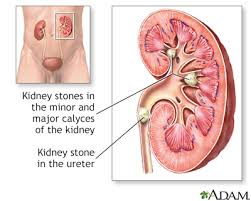The client has passed a renal calculus that is determined to be composed of calcium oxalate. Which discharge instruction should be given by the nurse?
Increase sodium intake.
Consider a move to an area with higher humidity.
Increase water intake.
Decrease intake of all calcium-rich foods and beverages.
The Correct Answer is C
Choice A Reason
Increasing sodium intake is not recommended for patients who have passed a calcium oxalate stone. High sodium intake can increase calcium in the urine, which can contribute to the formation of new stones. Therefore, patients are often advised to limit their sodium intake to reduce the risk of stone recurrence.
Choice B Reason
Considering a move to an area with higher humidity is not a standard recommendation for preventing the recurrence of calcium oxalate stones. While climate can affect hydration levels, it is more important for the patient to focus on direct measures to stay hydrated, such as drinking more fluids.
Choice C Reason
Increasing water intake is a key recommendation for patients who have had calcium oxalate stones. Adequate hydration is essential to dilute the urine, which helps prevent the formation of new stones. Patients are often advised to drink enough water to produce at least 2.5 liters of urine per day.
Choice D Reason
Decreasing the intake of all calcium-rich foods and beverages is not generally recommended for patients with calcium oxalate stones. In fact, a moderate intake of dietary calcium can help reduce the risk of stone formation by binding with oxalate in the intestines, which prevents it from being absorbed into the urine. Patients should consult with a healthcare provider or dietitian to determine the appropriate amount of dietary calcium.

Nursing Test Bank
Naxlex Comprehensive Predictor Exams
Related Questions
Correct Answer is ["B","D","E"]
Explanation
Choice A Reason:
A glucose level of at least 600 mg/dL is more indicative of hyperglycemic hyperosmolar state (HHS) rather than diabetic ketoacidosis (DKA). While both conditions involve high blood sugar levels, DKA is typically characterized by blood glucose levels that are high but not as extreme as those seen in HHS1.
Choice B Reason:
A fruity, acetone smell to the breath is a classic sign of DKA. This odor is due to the presence of ketones, particularly acetone, which is exhaled. It’s one of the key clinical manifestations that can help in the diagnosis of DKA.
Choice C Reason:
The absence of ketones in the urine would not be consistent with a diagnosis of DKA. One of the hallmarks of DKA is the presence of ketones in the urine, resulting from the breakdown of fats due to a lack of insulin.
Choice D Reason:
Polyuria (excessive urination) and polydipsia (excessive thirst) are symptoms of DKA. They occur as the body tries to eliminate excess glucose through the urine, which can lead to dehydration and the need to drink more fluids.
Choice E Reason:
Rapid, deep breathing, also known as Kussmaul respiration, is a compensatory mechanism for the acidosis seen in DKA. The body attempts to correct the acidic pH by exhaling more carbon dioxide.
Correct Answer is A
Explanation
Choice A Reason
Thiamine, or vitamin B1, is essential for brain function and the metabolism of carbohydrates. In the context of high blood alcohol levels, thiamine is administered to prevent Wernicke's encephalopathy, a serious neurological disorder. This condition is often precipitated by a thiamine deficiency, which can be exacerbated by alcohol abuse. Alcohol consumption can impair thiamine absorption and utilization, leading to depleted stores. Wernicke's encephalopathy is characterized by symptoms such as confusion, ataxia, and ophthalmoplegia, and if left untreated, it can progress to Korsakoff syndrome, a chronic and debilitating condition.
Choice B Reason
While alcoholic hepatitis is a concern in individuals with excessive alcohol intake, thiamine is not specifically used to prevent this condition. Alcoholic hepatitis is inflammation of the liver due to alcohol abuse, and its prevention primarily involves abstinence from alcohol, nutritional support, and medical management of liver inflammation. Thiamine does not play a direct role in preventing liver inflammation but is crucial for overall nutritional replenishment in individuals with alcohol use disorder.
Choice C Reason
Rehydration is indeed important for clients with high blood alcohol levels; however, thiamine does not serve this purpose. Rehydration typically involves the administration of intravenous fluids to restore fluid balance and electrolytes. Thiamine is not a rehydrating agent but is given to prevent neurological complications associated with thiamine deficiency, which can be seen in individuals with chronic alcoholism.
Choice D Reason
Preventing pancreatitis is not the primary reason for administering thiamine in this scenario. Pancreatitis, an inflammation of the pancreas, can be associated with chronic alcohol abuse, but thiamine is not used as a preventative treatment for this condition. The management of pancreatitis involves addressing the underlying causes, supportive care, and sometimes hospitalization for more severe cases.
Whether you are a student looking to ace your exams or a practicing nurse seeking to enhance your expertise , our nursing education contents will empower you with the confidence and competence to make a difference in the lives of patients and become a respected leader in the healthcare field.
Visit Naxlex, invest in your future and unlock endless possibilities with our unparalleled nursing education contents today
Report Wrong Answer on the Current Question
Do you disagree with the answer? If yes, what is your expected answer? Explain.
Kindly be descriptive with the issue you are facing.
